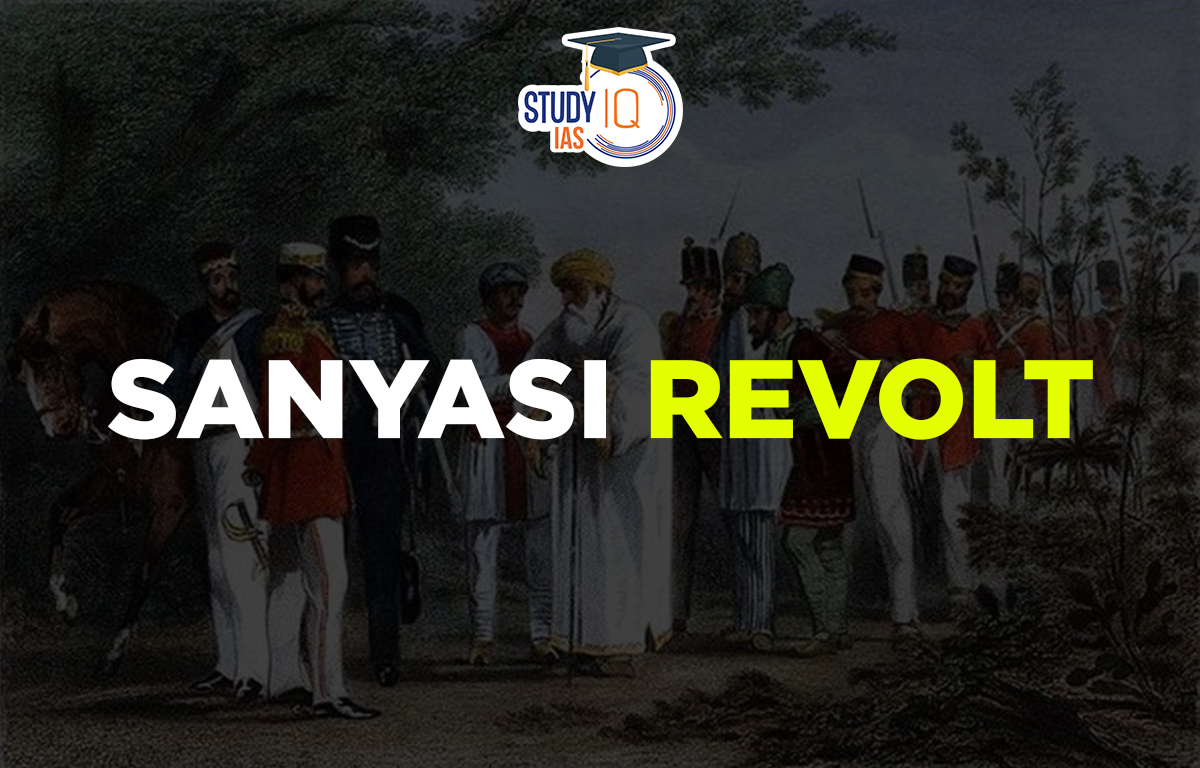Table of Contents
Sanyasi Revolt
Under the direction of Pandit Bhabani Charan Pathak, the Sanyasi revolt took place in the late eighteenth century in Bengal, India, in the Murshidabad and Baikunthpur woods of Jalpaiguri. Some describe the Battle of Buxar in 1764 as the first battle for India’s independence from foreign rule, while others categories it as violent banditry in the wake of the Bengal famine of 1770, which resulted in the depopulation of the province and the granting of the British East India Company the authority to collect taxes.
To prepare for the UPSC Civil Service Exam, this page will provide you with information on the Sanyasi Rebellion (1763–1800).
Sanyasi Revolt Objectives
- The Sanyasi Revolts’ main goals were to air their grievances and exact personal vengeance on the British.
- The Corporation and its allies were accused of repressing the peasantry, which was the primary Goal. The second goal was to take out the district magistrates, who were British officers. The commoners desired their magistrates.
- Following the Sanyasi insurrection, the Santhal Revolt (1855–1856) and the Chuar Revolt (1799) both took place in the western parts of the province. The Bengali novels Anandamath (1882) and Devi Chaudhurani (1884), written by India’s first modern novelist, Bankim Chandra Chatterjee, are among the best literary memories of the Rebellion.
Sanyasi Revolt Leader
The Fakir Revolt, as the uprisings were sometimes called, was notable for the equal participation of Muslims and Hindus. Majnum Shah (or Majnu Shah), Chirag Ali, Musa Shah, Bhawani Pathak, and Debi Chaudhurani were significant figures. The participation of Debi Chaudhurani recognises the role of women in early anti-British resistance.
Major Leaders of the Sanyasi Revolt
- Majnum Shah (or Majnu Shah): A well-known Muslim Fakir (Sufi saint) leader who was instrumental in mobilising the revolt, particularly in the initial stages. He roamed extensively to inspire resistance and brought together different groups of Fakirs and Sanyasis.
- Chirag Ali: He succeeded Majnum Shah as the leader of the Fakirs and carried on the struggle against the British.
- Musa Shah: A major Fakir leader, he was Majnum Shah’s brother and carried on the rebellion for a period.
- Bhawani Pathak (or Pandit Bhavanicharan Pathak): A Hindu Sanyasi leader of great influence, commonly regarded as a key figure in the rebellion, particularly in parts of Bengal. He is the central character in Bankim Chandra Chatterjee’s celebrated novel Anandamath.
- Debi Chaudhurani: A legendary female leader whose contribution underscores the place of women in early resistance against the British. She is also immortalised in Bankim Chandra Chatterjee’s book Devi Chaudhurani.
Sanyasi Revolt History
As a result of the severe famine of 1770 and the British government’s stringent economic policies, a group of sanyasis in Eastern India was compelled to rebel against the British yoke. The sanyasis were first peasants, some of whom had been forced off their land, but soon a sizable number of dispossessed minor zamindars, disbanded troops, and the rural poor joined them.
There are at least three different events that make up the Sanyasi Revolt. One is a sizable number of Hindu sannyasis who travelled to various Bengali districts from North India to visit shrines. On their way to the shrines, many of these ascetics would demand a religious donation from the local chiefs and zamindars, or landowners in the area.
The headmen and zamindars were more inclined to assist while the economy was booming. Bhawani Pandit. The main figure in the “Sanyasi Revolt” against British rule and exploitation in Bengal in the eighteenth century was Sharan Pathak. The Sanyasi Revolt was the initial anti-British insurrection in India.
Causes of Sanyasi Revolt
A famine struck the rural districts of British India’s Bengal province in February 1770. People moved from their villages to cities during the famine year in search of food and employment. The Bengal Famine: The First Great Crisis of Britain’s Indian Empire, historian Joseph Goldstucker claims that the famine caused massive migrations, with millions travelling by foot to Dhaka and Calcutta.
A small number of sanyasis in Eastern India were forced to revolt against the British yoke as a result of the devastating famine of 1770 and the British government’s strict economic policies. Initially, the Sanyasis were peasants, some of whom had been driven off their property, but soon a sizable percentage of the lesser zamindars who had been driven off their land had disbanded their forces, and the rural poor joined them.
The Sanyasi Revolt is made up of at least three distinct incidents. One is the significant number of Hindu sannyasis who travelled from North India to various Bengali districts to visit shrines. Many of these sadhus would request a religious gift from the zamindars and other local officials before beginning their journey to the shrines. When the economy was prospering, the zamindars and headmen were more likely to provide a hand. As a result of the zamindars’ diwani obligations to the British government, this had grown challenging.
Because the Brits believed the Sanyasis to be looters, they forbade them from entering sacred sites. The Sanyasis revolted against the British and looted government funds and factories in England. Pandit Bhawani Sharan Pathak was the leading figure in the “Sanyasi Revolt” (18th century) against British rule and exploitation in Bengal. The Sanyasi Revolt signalled the start of the Indian anti-British uprising.
Significance of Sanyasi Revolt
Thousands of peasants were perishing in the fields and woodlands every day. The famine was attributed on the British East India Company. The Company was viewed as an unpleasant oppressor who used excessive taxes to take advantage of the peasantry. To get justice for their complaints, the peasants turned to violence against the Corporation and its allies.
In Baikunthpur, a rebellion started in April 1770. More than thirty occurrences of Sanyasi Revolts, known as “Sanyasi Revolts,” occurred in Bengal Province alone between 1770 and 1779, including several in Murshidabad.
Sanyasi Revolt Failure
Caste discrimination in society, which caused internal strife, was one of the main causes of the Sanyasi Revolt’s collapse. The societal ills that Pandit Bhabani Charan Pathak saw in his neighbourhood were the subject of his sermons. He was kind to other people. He also criticised the zamindars’ authority, which he believed to be corrupt.
Bhabani The caste structure, where upper castes maintained the status quo, is the root of Charan Pathak’s uprising. In contrast, there were disputes amongst lower castes based on political influence and religious identity. When non-Hindus spoke out against the exploitation or mistreatment of Dalits, the higher castes utilised violence against them to maintain their privileges and authority over them.
| Related Articles | |
| Indigo Revolt | Revolt of 1857 |
| Young Bengal Movement | British Administration System |
| Freedom Fighters of India | Partition of Bengal |


 Maharashtra’s Mendrachi Vancharai Syst...
Maharashtra’s Mendrachi Vancharai Syst...
 Keeladi Excavation: Uncovering the Ancie...
Keeladi Excavation: Uncovering the Ancie...
 Indus Valley Civilization, History, Phas...
Indus Valley Civilization, History, Phas...





















